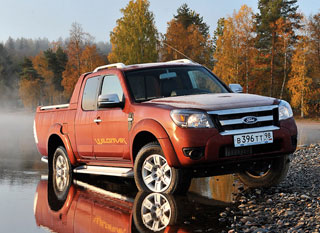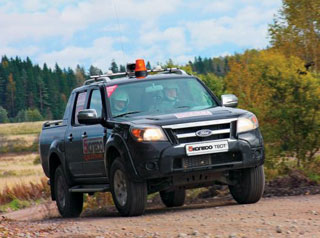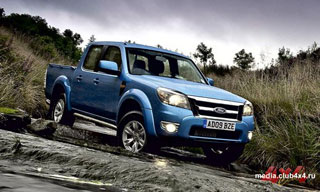Test drive Ford Ranger 1992 - 2010 compartment
When hunting
It is time to hunt! In the wakes that the Korean-Chinese rhino has recently protected to the domestic market, we launched an experienced rainer from America.To put against the Ssangyong Musso Sports pickup Pickup Ford Ranger allowed us that the latter with your Clone Mazda B-series is the most successful acquisition in the price category where our rhino marks. Ssangyong pickup in minimal configuration costs from $ 21,990. Of course, the Mazda would fit more for a duel, because its price starts at $ 21,350, and for Ford, as you can see even from $ 23,100, they ask for $ 23,100. However, today's B -series is a passing phenomenon, the model will change at the end of the year, and Ford Ranger seems to be not going to take a position yet.
The cars we have taken for the test are equipped at about the same level, which means an average degree of equipment for MUSSO, and for the Ranger utilitarian - almost maximum. Here we need to make a link to the fact that Ford positions its pickup as a workhorse, and Ssangyong built MUSSO Sports on the SUV platform, which at one time was positioned almost like a business class. The Korean pickup has even a version with automatic transmission, which, from the pickups officially sold from us, except for it, only the latest Navara, which costs a good $ 10,000 more expensive.
So do not be surprised at the presence of an electric package, ABS and other charms in the basic configuration of MUSSO Sports. The minimum equipment of Ranger is much more modest. However, realizing that pickups in Russia will be something else for just a means of delivery of goods for a very long time, and in general, the requirements for cars of all types are growing, Ford equipped its truck with a number of options, including air conditioning, airbags, ABS, audio system . In this form, it is already worth $ 27,600, and the Ssangyong Musso Sports - $ 23 940, who has come out with it, has come to fight with it. True, in each case you need to add at least a couple of thousands for plastic volumetric caps of the cargo compartment.
Living classic?
Ssangyong Musso is over 13 years old, pickups have been released on its platform for four years. We will not talk about the age of Ford Ranger so as not to disturb the dust of the centuries. We only mention that he underwent the last restyling in 2001. Both survived some modernization of the units, but in fact they remained themselves. A frame platform with an independent torsion front suspension, sprinkle for Ford and Ssang -Yong spring, dependent rear, connected all -wheel drive - nothing changes under the moon! In fact, there are really few differences. The Ssangyong engine is a 2.9-liter 120-horsepower OM602 with a turbine assembled under the Daimler license, the gearbox is also licensed, in the rear bridge a differential of high friction, again in the basic configuration. This diesel has a very smooth and even curve of torque growth, it is somewhat phlegmatic, but flexible and traction. A 2.5-liter Mazda turbo engine with a three-valve timing technology with a capacity of 109 liters is placed on Ford. With. And a kind of characteristic of the moment with a clear hump at 2000 revolutions.
In the photo where the pickups are nearby, it is clearly visible that the Ssangyong Musso Sports is slightly lower and the Ford Ranger, its hood and the cabin are longer, and the body is shorter. This, in fact, is the essence of the represented models. If you divide the abbreviation of the SUV into the components of the parts in relation to our duels, then Ssangyong will get more S - from sports, and Ford, respectively, U - from utilitarianism. This is not directly related to the characters and behavior of cars, rather to a hypothetical purpose. Koreans, presenting their sports rhino in 2002, served it against the backdrop of a young family frolicing on the grass with mountain bicycles, kayaks and striped beach balls in an embrace. Ford depicted Ranger’s tramp against the background of rocks surrounded by types of country-style-style, and only sometimes in the back was the enduro class motorcycle. Nevertheless, if the Ford was once intended for hard work, now I have moved into the category of a practical, but cult car. Well, Ssangyong was originally ready to quit everything and rush to nature to swim ... And why else do you need all -wheel drive pickups at a price of $ 30 thousand? Take firewood?
Strong and light
The joy of meeting with our duels was somewhat spoiled by the weather: either the sun and drops, then the blizzard a la Alaska and snow above the knee ... In a word, getting into the fields, we took with us all possible means of salvation, and they all came in handy to us. First, Ford fell into a hole covered with snow, I had to dig around it around the perimeter to get out, after Ssangyong, it pulled a rut on a soft parapet, then MUSSO was stupefied on a pile of crushed stone. So, twitching each other with a cable, we walked along the environs of pampas, getting used to the nature of the pickups. In the course of the case, they found the lack of towed vominations in the back, which was very puzzled - the car was not for intra -factory transportation.
It is quite difficult to judge the differences in the patency of standard machines of this type, especially when you consider that one was on a real winter stormy rubber, and the second on the universal M+S. But, as before, it can be noted that the most critical places in pickups are the length of the wheelbase - it is likely to catch the thresholds of the fracture of the relief - and independent pendants that willingly perform the mission of the landing platform. Ssangyong has not too strong protection of the motor compartment, and the crossbar of the frame under the hand -up box Ford acts like a plow. The corps of differentials of the rear bridges of our cars is small, and if the front line has passed over the obstacle, then the head may no longer hurt. To catch on, say, on the descent with the rear over the ground, it is unsuitable - there is a reserve, and in the future there must be a towbar, but it is much less pleasant to bury the front. If you bury the wheels in the snow on the hub, both hydraulic boards are not able to turn them. During the pogazovka, it turns out that either the Ssangyong amplifier is slightly larger, or, more likely, the gear ratio of the steering gearbox is higher.
Reducing gearboards of both are strong enough and allow you to move softly. At the same time, if you need to give heat, this maneuver manages Ford much better than the hardwheat muso. The same can be said about the accuracy of control, and the reactions to small angles of rotation of the steering wheel. What the Korean definitely wins is in the smoothness of the course and the comfort of crossing the crossed terrain. Fast riding on unloaded pickups, in principle, is a doubt pleasure, and on a winter nomadic road just shakes the soul, but the Ssangyong suspension tries to swallow irregularities, and the amplifier to soften the jerks of the steering wheel. The cowboy Ford, in turn, with all his might wants to show that he is also a sport, albeit utilitarian, and arranges a real rodeo to the riders. This is not bad, only the steering wheel will have to be kept with an open grip, because it is torn from the hands when it gets into the rutuslessly. When you calmly traveling for your fingers, you can not be afraid.
The selection of transmissions of the presented pickups is different. Ford has the first very short, as is the case with most SUVs. The second, just the opposite, is stretched to impossibility, the third, fourth and fifth go evenly behind it. Such a series allows you to effectively realize traction on the off -road and feel quite confident in the city stream. Ssangyong does not have pronounced short and long gears, which, however, does not interfere with a rather vigorous acceleration. For the dynamics, however, the painful engine should be thanked. MUSSO transfers mechanism, like all other controls, works somewhat cotton, but the programs are stuck very clearly. The Ranger box lever, on the contrary, jumps from place to place cheerfully, but the transition itself, the inclusion of the selected speed is carried out with some kind of incitement.
Micromy
The pickups are always a problem in parking, and with those on which high covers of the bodies are installed, the problem is doubly. The sightseeing of the driver is good only forward. The lateral mirrors on both of our cars are convex, and determine the distance to a brilliant false film of the radiator of the luxurious sedan, to which we are trying not to be moored by the stern. Almost nothing is visible through the intra -axial mirror. This is to blame for the tinted glass of roofs, and sticking dirt, and the snow that covered all this disgrace. After a supermarket parking, you begin to be especially sharply aware that you are driving a truck, besides not so small ... But in the salons of our duelists it is quite comfortable. As for the level of comfort, we now have just the case when we can say that convenience is a relative concept ... however, the cabs of pickups and absolute, if you like, features. Say, the Ssangyong salon is noticeably longer, there are more places for passengers of the second row - and this, of course, is really important. At the same time, high -growth drivers are equally convenient or inconvenient both there and there. In Ranger, the landing is slightly lower, and the seat pillow, unlike MUSSO Sports, is not adjusted along the angle of inclination. This adjustment, however, does not save the situation too much, especially since using it is somewhat difficult. In Ssangyong, you sit noticeably higher, which does not mean more convenient. The owner of the large legs will not like it much there: even at 43 size, being, however, in winter boots, I all the time touched the lower edge of the front panel of the Korean, transferring my leg from the accelerator pedal to the brake pedal.
The secondary governing bodies are organized well, but nothing more. Ssang -Yong Audio is lower than the air conditioning - to switch the station, you have to be distracted from the road. Ford is not very conveniently located cup holders, in front of the levers of the transmission. By the way, about levers: Ssangyong and Ford is in different ways. In Ranger, this provides a familiar handle of a hand -box, plus a bonus - the opening button of the pennance of the front. The mode of switching the modes is slightly confusing: if the opening indicator burns, then the half -axle is connected and all -wheel drive can be activated directly on the go. But if the light does not burn, then you need to stop, otherwise you can’t connect the front line. Ssangyong Musso with this business is easier. You can go to 4x4 mode at a speed of up to 80 km/h by pressing the key, moreover, the reducing gear can also be turned on in the movement, however, the speed must be reset to the minimum. The switching process itself takes a couple of tens of seconds, which in a critical setting annoys incredibly.
Virtual cargo
The main part of any pickup, distinguishing it from other vehicles, is, of course, a body. Before you call the winner in this nomination, let's try to figure out what is it in. Firstly, you can put dirty and wet, such as a cross-country motorcycle or kayak, not to mention a large hunting trophy in the body. Secondly, the ability to remove the roof and back the side allows you to transport a large-sized cargo as part of the agreed traffic rules. Thirdly, in any case, more equipment will enter the body than in the trunk similar in the class of SUV. I used a pair of snowboards for a practical experiment: one 170 cm long, the other - 150. simple manipulations showed that Ranger includes only a smaller board in length, and even it will not fit into the Ssangyong body. True, a more naughty snowboard fit into both bodies: only Ford entered easily, and barely squeezed into Musso. Given that the length of the heavy -wheel drive ATV is about 180 cm, then it is clear that with a raised rear board it will not even enter Ford. The roof will not allow either a motorcycle or a quadrick to roll there. Unless to dump a couple of bicycles on the floor. In a word, despite the fact that in the absolute standings in the size of the body, Ranger came to first place, you should estimate in advance why this very body will be used, and not think, they say, since this is a pickup, then the snowmobile will definitely go there.
To whom?
What would I prefer? I can’t give a definite answer even after a few days of tests. If I have a larger family and smaller snowboarding, I would probably take Ssangyong Musso Sports. His interior is more spacious, the equipment is richer and the price is lower. But if you gather with friends and karelia in Karelia for three weeks, then Ford Ranger would come up. The volume of the body can be a more important factor. That's just the price ... in the form in which he came to our test, the cost of Ranger will be about 30 thousand dollars. Ssangyong is still more profitable, and he is more comfortable. But traveling on even roads is still more pleasant on Ford.
Text: Igor Gubar
Source: Magazine 4x4 [April/2006]



